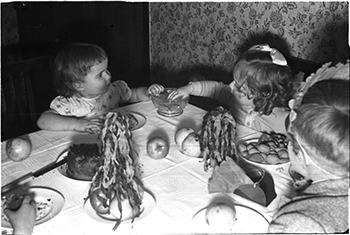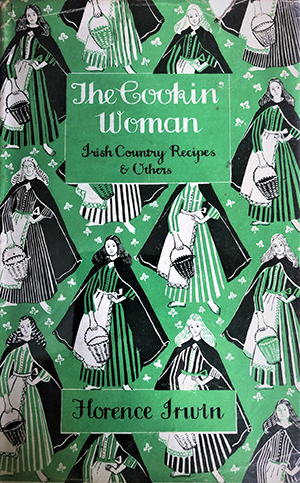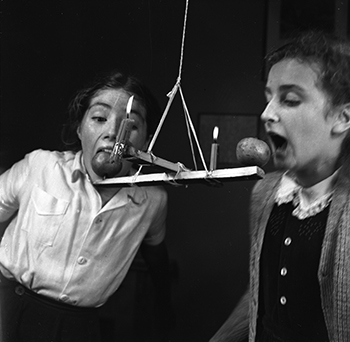Between the realms
Published in Features, Issue 6 (November/December 2020), Volume 28Food for humans, fairies and the dead at Hallowe’en.
By Regina Sexton

Above: Hallowe’en brack with apples and nuts for a children’s party, c. 1935, Dublin. Bakery yeast-leavened barmbracks were well established by the second half of the nineteenth century and, like home-made sweet fruit cakes, they contained an assortment of charms that symbolised one or multiple life states and transitions: a ring (for marriage within the year); a coin (riches); a bean (riches/cross water); a pea (poverty); a rag (raggedness/death/religious vocation); a thimble (marriage to a tailor/dressmaker); a holy medal (religious vocation); a button (bachelorhood/spinsterhood); a sloe (death); a nut (never marry/cross water); a horseshoe (good luck); and a stick (beatings by a future spouse/never marry/first to marry/death/religious vocation). (Maurice Curtin/National Folklore Collection, UCD)
In his seminal 1972 publication The year in Ireland, folklorist Kevin Danaher identifies May Day (Bealtaine) and its partner half-year festival Hallowe’en (Samhain) as the two main days of ritualised celebration in the Irish calendar year. These secular festivals were traditionally anchored in the patterns of the agricultural year, with food as a principal concern. While Patricia Lysaght has examined the significance of the domestic dairy economy at May Day, the centrality of food to the festival of Hallowe’en has received little but light treatment. Danaher covers the main features of the role and function of food at Hallowe’en but, given the depth of detail in the available source material, in particular that in the National Folklore Collection (NFC), a deep interpretative analysis of the data is yet to be realised. What follows is an outline descriptive insight into this underexplored rich vein of material through the lens of food and its meanings at Hallowe’en.
National Folklore Collection
The Main Manuscript Collection and the Schools’ Collection (1937–9) of the NFC provide significant descriptive detail, memories and stories of a Hallowe’en food culture. Food was at the core of this end-of-agricultural-year festival, having many practical, ceremonial and symbolic functions. The festive meal had two main components—a savoury potato dish and a sweet bread, with satellite items such as cabbage, turnips, apples, nuts, sloes, herrings, peas and beans, playing roles in future-telling games, especially marriage divination. Some foods had multiple functions: apples and cabbage, as high-profile Hallowe’en foods, could slip between the roles of culinary ingredient, the object of children’s games (snap apple, apple ducking) and neighbourhood pranks (raiding the cabbage garden for ‘kail runts’) to highly ritualised uses in love-forecasting and marriage divination.
Equally valuable and ethnographic in nature was the work of Florence Irwin. In her 1937 Irish country recipes, she writes of Hallowe’en:
‘No other day in Ireland is celebrated by so many special dishes. They are all vegetarian, of course, but are so popular that they provide real feasts on Halloweve night. County Armagh celebrates with potato apple dumpling, and potato apple cake. Counties Tyrone, Cavan, Fermanagh, and Londonderry indulge in boxty pancakes, boxty dumplings, boxty bread, potato pudding, and colcannon. No matter which is the dish chosen for Halloweve night’s fast (or feast), a wedding ring carefully wrapped in greaseproof paper … is put into it.’
However brief the description, Irwin provides a dense synopsis of the main features of Hallowe’en food: its strong seasonal accent and the dominance of potato, with local difference, and its alignment to two belief systems and their associated rituals—the Catholic obligation to abstain from meat on the vigil of All Saints’ Day and the folk beliefs that invested food with symbolic significance.
‘Colcannon Night’

Above: A 1949 edition of Florence Irwin’s Irish country recipes. Irwin was a food and cookery writer with the Northern Whig newspaper from 1907. Between 1905 and 1919 she collected a body of traditional recipes and anecdotes through her work as instructress in domestic economy for the Department of Agriculture and Technical Instruction in Northern Ireland.
The food mentioned in the folklore accounts reflects the domestic culinary practice of self-sufficient rural communities. Urban difference is occasionally expressed, as in the case of celebrating with coconuts, oranges and grapes in parts of Dublin, but overall a mashed potato dish was the standout festive meal, as evident in the designations ‘Cally’ or ‘Colcannon Night’ as alternative names for Hallowe’en in some areas. The meal partner, a sweet bread, was a home-made fruit bread (usually soda) or a factory-made barmbrack. Boxty in sweet or savoury forms gave both local and regional character to Hallowe’en food in areas extending from the Ulster counties to Leitrim, Sligo, Longford, Roscommon, Galway and into parts of Westmeath, Offaly and Kilkenny. Potatoes harvested in late autumn were considered especially tender, with culinary properties suited to boxty-making. In some areas, a sweet accompanying sauce gave an additional festive embellishment to boxty dumplings.
The source material is not simply a snapshot of custom in the first half of the twentieth century; rather its tendency to slide backwards in time through memory and recall provides insights into practice that had all but disappeared by the 1930s/40s—the emphasis on oatcakes, for instance, in many of the northern accounts captures an earlier period when the prevalence of this versatile grain made oat-based dishes and breads a distinctive feature of dietary systems in the northern, north-western and some eastern counties. The elevation of oatcakes to festive status is remembered in one Donegal informant’s (Schools’ Collection) description of Hallowe’en ‘soul cakes’ made special with the addition of sugar and shaped into squares or triangles and eaten throughout the night to invoke good fortune for the new agricultural year.
Food played a central role in the performance of Hallowe’en rituals, with the pre-meal, meal and post-meal activities framing a symbolic system that distinguished festive from everyday custom and practice. In this highly ritualistic approach, heavy with symbolic action, commonplace dishes and ingredients like a currant loaf, a bowl of mashed potatoes and a head of cabbage or the simple act of adding or withholding salt were invested with power that gave access to an invisible world in attempts to call up the future. Certain strategies common to ritualised performance put Hallowe’en custom at a distance from the everyday; for instance, the festive meal had a certain structural formality, with specific associated behaviours and activities positioned around its consumption. The meal was taken in the evening, with the expectation of its special status affirmed in the many instances of informants calling the Hallowe’en meal a ‘great feast’ and one of the two great feasts in the calendar year—the other being Christmas. The returning dead often joined the feast but remained invisible. In some accounts, revenants seeking prayers returned during the night, and their offering was left overnight near the hearth or on the table, thus extending the ceremonial meal to beyond the living realm.
Gender division
The post-meal evening-to-sunrise period was given over to mischief and games of future/fortune-telling, with food playing a central role. A degree of gender division marked the post-meal activities, with girls engaged in games of marriage divination in or near the house while young men were more inclined to neighbourhood mischief-making, boxty-stealing, alms-collecting and music-making with Wren Boy-like groups such as the Caitileens in Leitrim and the Baw-Men in Kildare. While not exclusively gender-specific, activities like the apple/mirror test, the formalised arrangement of girls’ clothing overnight before the hearth and the ritual eating of a salty herring to induce dreams of lovers tended towards female engagement and performance. Other activities had meaning only if performed in a communal context where each participant moved between the role of audience member and performer. Many of the post-meal fortune-telling activities—sharing the barmbrack, ducking for apples and roasting nuts in pairs to determine the love fortune of named couples—made sense only through shared group experiences.
The patterned structure of the festivities saw food as product, ingredient, dish and symbol, which brought cohesive unity with flow-through from the routines of the field and kitchen to the sacred or the cosmic realm. This is well illustrated in the examples of cabbage and colcannon. The ritual of pulling the cabbage heads by the root moves from the garden to the kitchen for preparation and on to the consumption of colcannon in formalised, structured and symbolic ways: typically, and with many variations, blindfolded girls pulled the heads; the heart was judged on flavour; and the root was read for shape and length as an indication of the temperament and physical characteristics of a girl’s future partner. Colcannon was sometimes eaten in a silence broken only by an incantation to peeled stalks of yarrow, while spoonfuls of the dish were placed in the left or in both stockings and left by the bed or hanging on the door to reveal at a real or a dream level the identity of a girl’s partner.
Exaggerated behaviours or the stylisation of everyday physical activities are prominent features of Hallowe’en that bring the body and food together to connect with the otherworld. The examples are many, from the strongly tactile nature of playing the fortune plates (touching clay, water and flour) to the highly stylised midnight rituals of the apple test (combing one’s hair while looking in a mirror and eating an apple to draw up a future lover’s reflection) or holding food (five beans) and water in one’s mouth to receive in silence a future partner’s name by listening in secret to conversation outside a neighbour’s door.
A tangle of different belief systems

Above: Hallowe’en games, c. 1935, Dublin. Descriptions of the game of biting or snapping apples from the cross-stick appear in antiquarian accounts from the late eighteenth century and they are the subject of a number of artistic representations of Hallowe’en festivities. The object of the game was to bite the apple and to avoid the lit candles or bars of soap. (Maurice Curtin/National Folklore Collection, UCD.)
While the body/food union was central to mediating communication with the cosmic realm, the nature of that realm and the body/food and cosmic relationship were complicated by upholding a tangle of different belief systems. In the pre-Vatican II period, participants in Hallowe’en’s highly ritualised evening of symbolic activities were expected to abstain from meat before All Saints’ Day to mortify the flesh in preparation for the liturgical feast. The parallel activities of indulging the senses, physically and figuratively, in the secular and folk tradition set up a tension between these two belief systems, as clearly seen in the oblique referencing of sexual activity in the games that read cabbage roots and in the love-divination rituals that involved intimate items of clothing like smocks and stockings.
A comparable mix of beliefs is also evident in the offering of food to otherworldly beings: the fairies and the dead. Fairy food, no different from human food, was usually a portion of the festive mashed potato dish, sometimes with oatcakes (Donegal), that was set aside overnight by the hearth or on the table. To extend a welcome to the fairies, the house door was left on the latch, the hearth was swept clean and spoons were provided with the food bowl. The offering served to appease the fairies, to garner their goodwill and to pre-empt their needs as they moved around the landscape at Hallowe’en. The following is a County Galway account from the Schools’ Collection:
‘The first plate of this [colcannon] is kept for the fairies lest they should [be hungry] while changing from their Summer residence to their Winter home. No salt should be put on their portion.’
Food also had the power to protect against the malign work of the fairies, especially as directed towards children. Oatmeal, butter and salt placed on children’s heads had protective qualities to keep them safe from fairy malice at Hallowe’en.
In Irish Hallowe’en tradition, a wide range of food and dishes, while seemingly simple and everyday, took on temporary animistic qualities, which lifted them from their everyday role and functions and imbued them with a differentiating spirit and energy.
Regina Sexton is the Programme Manager of the Postgraduate Diploma in Irish Food Culture at University College Cork.
FURTHER READING
K. Danaher, The year in Ireland (Cork, 1972).
P. Lysaght, ‘Women, milk and magic at the Boundary Festival of May’, in P. Lysaght (ed.), Milk and milk products from medieval to modern times: proceedings of the Ninth International Conference on Ethnological Food Research (Edinburgh, 1994).
















